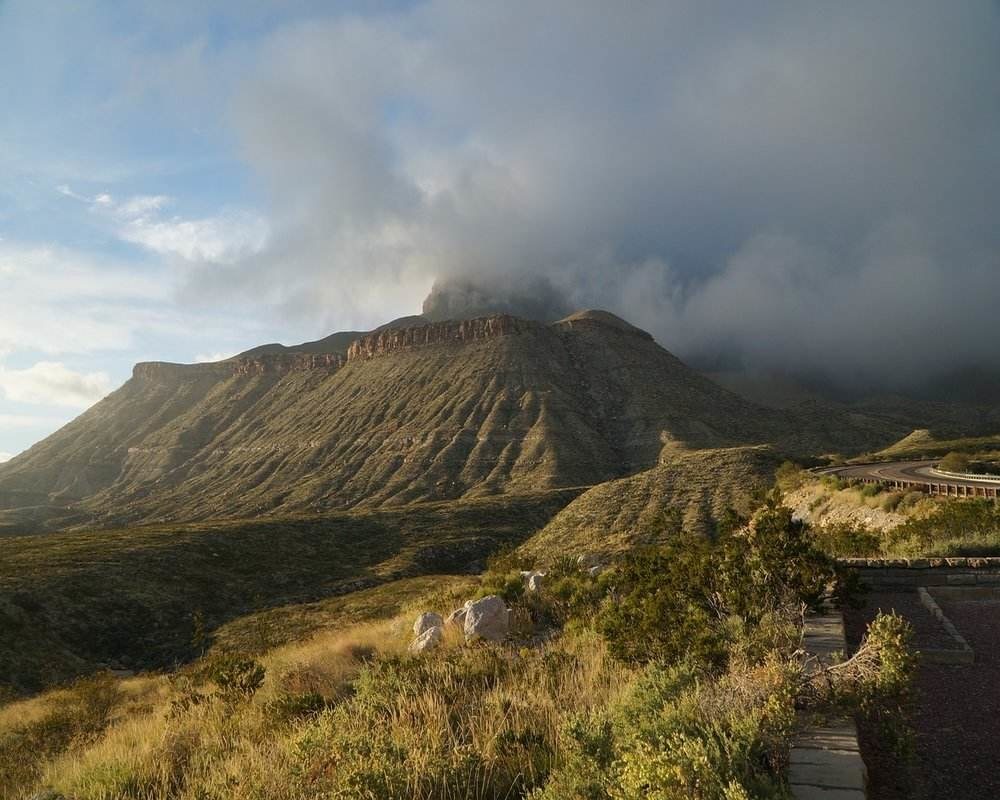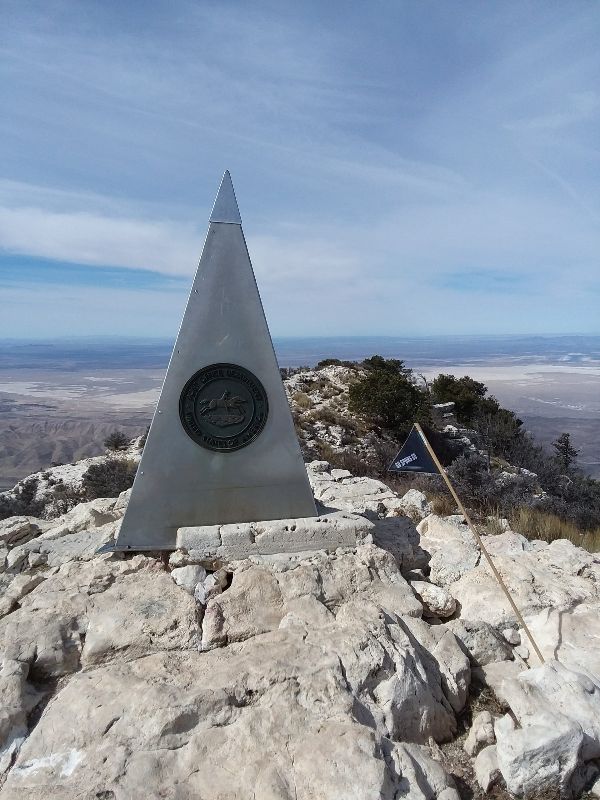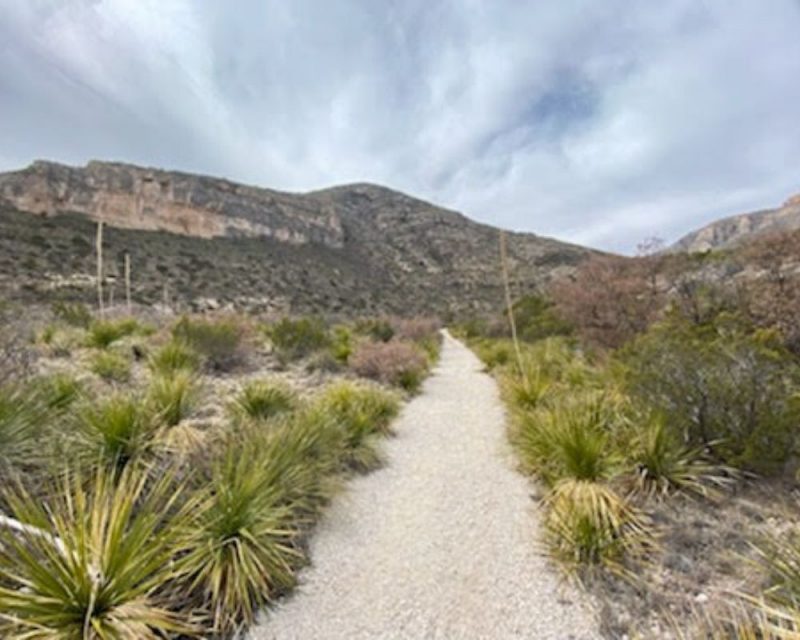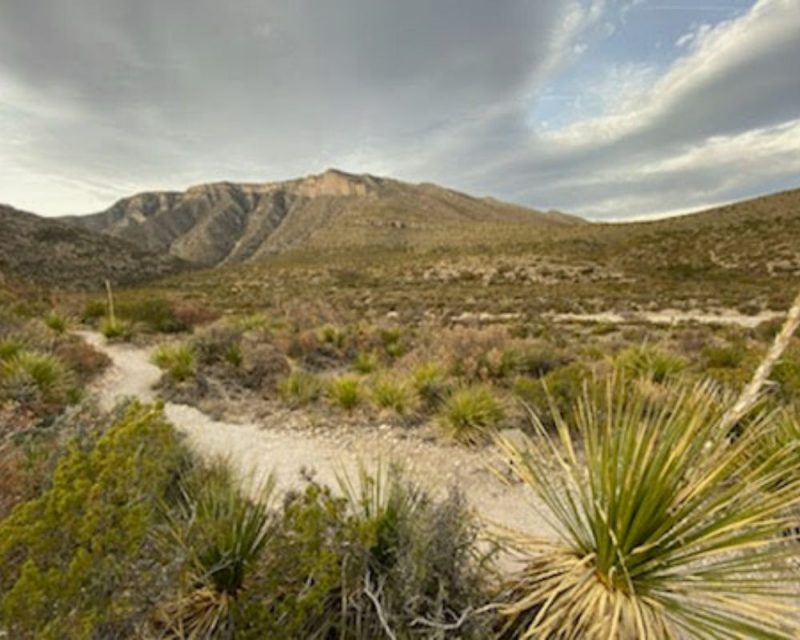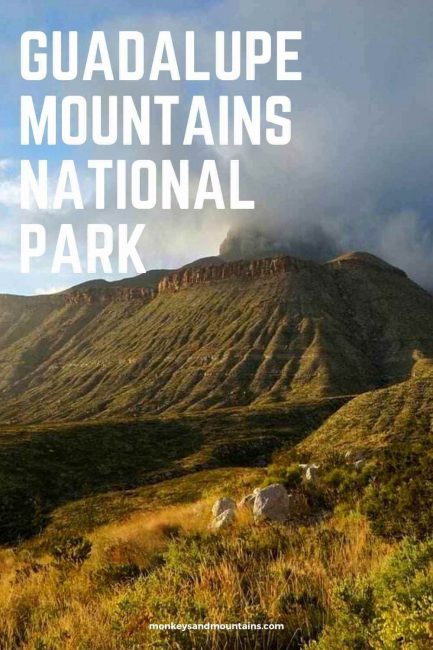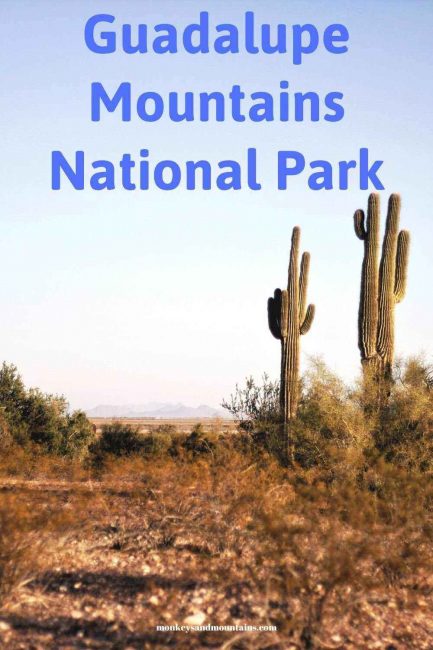An often overlooked secret of west Texas is the Guadalupe Mountains. The Guadalupe Mountains National Park in Texas should be on every adventurer’s bucket list.
Table of Contents
The Guadalupe Mountains are a fascinating site to explore. Fortunately, there is a National Park that embodies the best of this Texas mountain range. Allowing its visitors a chance to experience all of the natural opportunities these mountains provide.
This park characterizes the best of Texas outdoors! Guadalupe Mountains National Park is a haven for those hikers, campers, and mountain appreciators in search of serene, secluded, and rugged adventures.
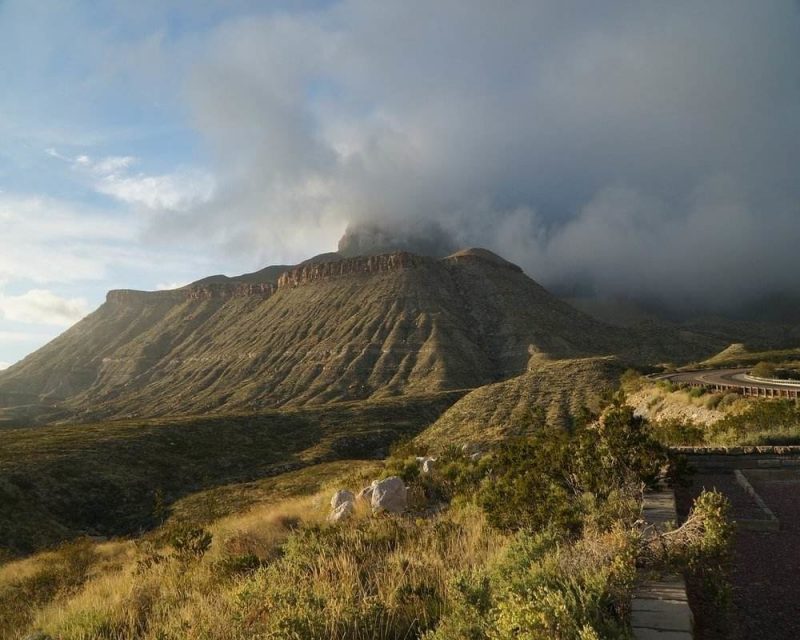
Related Reading: The Best Women’s Clothes for Hiking: A Guide to Everything you Need
Where is Guadalupe Mountains National Park
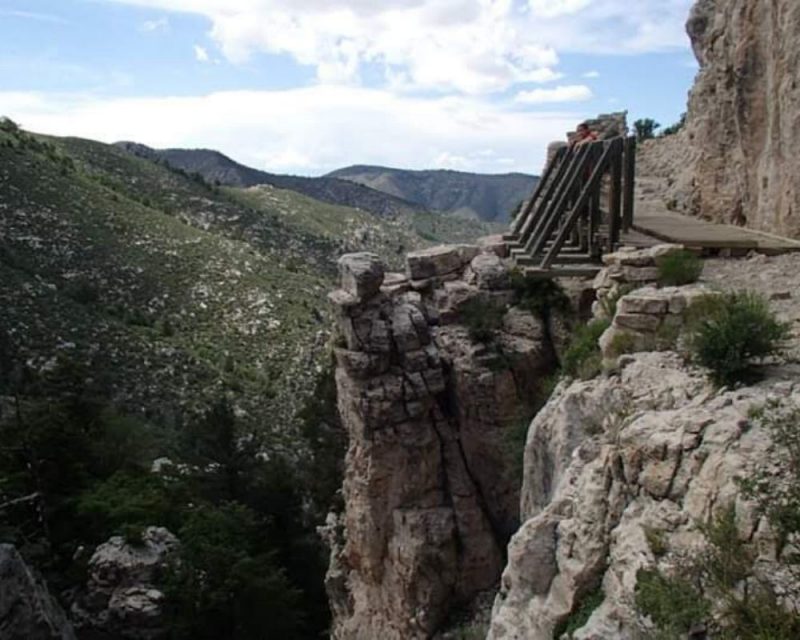
Guadalupe Mountains National Park is located in the far western portion of Texas. It is approximately two hours east of El Paso, and about an hour southwest of Carlsbad, New Mexico. Ironically, Carlsbad Caverns National Park is hewn from the same mountain range, the Guadalupe Mountains. This gives these two neighboring National Parks a special bond!
Related Reading: The Top 7 Hikes in Death Valley California
Guadalupe Mountains National Park is remote, and therefore not the easiest park to get to. El Paso has the nearest international airport. So even flying to Guadalupe Mountains National Park requires several hours of subsequent driving.
Keep in mind that Texas is one of the largest states. So expect to travel to discover this wonderful National Park. Not to worry though, you can easily rent a car at the airport and who doesn’t love a good road trip.
The upside to Guadalupe’s remoteness, however, is the benefit that visitors can reap from all that seclusion to enjoy the gentle nature or a 4.2-mile roundtrip hike. There is always something for everyone.
Guadalupe Mountains National Park is one of the least visited National Parks in the country. Which makes it a top contender for those looking for a peaceful, uncrowded, and natural National Park experience. It is the perfect place to truly get in touch with nature, miles away from civilization’s touch.
Related Reading: Hikes Near Seattle that You Just Have to Try
The Best Time to Visit Guadalupe Mountains National Park
Guadalupe Mountains National Park has seasonal highlights to offer, no matter when you visit this Texas gem!
A visit in winter will guarantee a hiking or camping experience draped in solitude. For those looking to really get away from it all. The great thing about a winter visit to Guadalupe is that the moderate climate of the West Texas desert still supports manageable winter temperatures for outdoor activities.
Spring brings life, water, and wildflowers to Guadalupe. It is a great time to witness the emergence of both new wildlife and plant life. Specific parts of the park, like McKittrick Canyon, are particularly vibrant this time of year.
Summer is the season in the Guadalupe Mountains National Park that comes with the strongest advisory. Guadalupe is surrounded by the Chihuahuan desert, which means that summer can bring some brutal Texas temperatures along with it.
A visit in summer necessitates careful planning in regard to sun protection and hydration. Bring sunscreen, a head covering, suitable clothing that is moisture-wicking and breathable, and most importantly, food supplies and plenty of potable water.
Finally, fall in Guadalupe Mountains National Park is a real show-stopper. Certain vegetated, lush regions of the park, like McKittrick Canyon, are full of stunning autumn trees displaying reds, golds, and oranges that easily rival the Northeast!
Related Reading: Touring the Grand Canyon National Park: What You Need to Know
Know Before you Go to Guadalupe Mountains National Park
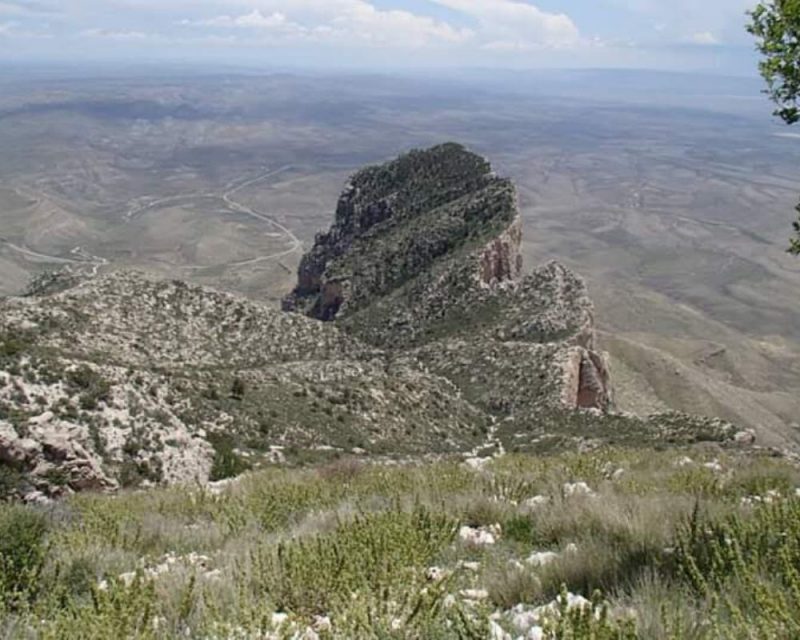
This park is remote and because of this, there are a few things that you should know before venturing into this part of Texas. Here are some quick facts to keep in mind:
Related Reading: Visit Glacier National Park: Everything You Need to Know
Go with Enough of Everything
Due to its remote location, be sure to fill up on necessities, such as drinking water, gas, and groceries, before reaching the immediate area of Guadalupe Mountains National Park.
Approaching from the north, Carlsbad, New Mexico is a good last stop. If arriving from the west, plan to stop in El Paso.
Related Reading: The Best Hiking Jackets for Every Season
Camping in the Park
There are two campgrounds in Guadalupe Mountains National Park. Dog Canyon Campground is located at the north end of the park and is a great way to experience mountains. And Pine Springs Campground is near the southeastern edge.
Both campgrounds are first come first serve. Basic campground amenities are available but there is no reservation system in place. So if camping, plan to arrive early to secure your spot, or have a backup lodging plan available. Charcoal fires and wood fires are prohibited, due to the consistently dry conditions and frequent desert wind gusts in Guadalupe.
Recommended Reading: Why You Need Adventure Travel Insurance and Our Top Recommendation.
Backpacking in the Park
There are several backpacking spots available within Guadalupe Mountains National Park. One route leads through the Chisos Basin area. This trail takes hikers along the Rio Grande River and past some beautiful scenery.
Another popular backpacking route is the Cienega Trail. This trail begins at the end of the road leading to the park entrance. Hikers must cross the river twice during this hike. You can also check out the bush-blue ridge loop
Hiking in the Park
This is a great place to go hiking and camping. There are many trails to hike, including the Guadalupe Mountains National Park Trail. The trailhead is located at the end of Hwy 70 (the road to Alpine).
Depending on your level of fitness you can go on a number of select hikes. There are several short hikes within the park. Some of the shortest hikes I went on included the Chisos Basin Loop Trail and the Big Bend Ranch State Park Trail which lasts about 1-2 hours or 3-5 hours depending on your pace.
Pets in the Park
There are a few places where pets are allowed i.e. in Guadalupe’s campgrounds, as well as the short Pinery Nature Trail at the Pine Springs Visitor Center. Pets are not allowed on other trails or in other areas of the park.
Wildlife Encounters
Guadalupe Mountain contains a wide variety of flora and fauna. A mountain gem that hosts desert environments, creosote bushes, a variety of Cacti, salt flats, and a stretch of mountains thus expect to have an encounter with the wildlife. Nature enthusiasts will love the different species of mammals and bird species that reside here.
At the highest elevation, where temperatures are typically 10°F colder than at sea level, there are extensive stands of pines. These forests are home to animals including elks, black bears, gray foxes, mountain lions, and different species of reptiles.
What to Wear for Hiking
Despite the misconception that Texas is all flat, there is substantial mountainous elevation and higher altitude hiking here. All thanks to the Guadalupe Mountains!
Hiking in Guadalupe is best done with a good pair of reliable, sturdy hiking boots, to best traverse the changes in elevation and rocky conditions here. I really wouldn’t recommend hiking sandals for this one.
Entrance Fees
The entrance fee for Guadalupe Mountains National Park is $10 per person and is valid for 7 days. Entrance fees may be paid in person with cash or credit card at the Pine Springs Visitor Center. Or through self-pay stations found at all the park’s trailheads. Self-pay stations include green envelopes in which to deposit payments.
Recommended Reading: 15 VRBOs in Phoenix, Arizona
Camping in Guadalupe Mountains National Park
The Pine Springs Campground is located adjacent to the Pine Springs Visitor Center and park entrance. The setting of this campground is considered primarily high desert, as it is located at the base of the mountain range.
There is limited shade here, and the wilderness campsites are more exposed. This means it may become hotter during the summer months.
Dog Canyon Campground is located in the northern portion of Guadalupe Mountains National Park. It resides at a higher elevation and is thus more vegetated and forested. Average temperatures will likely be cooler here than at the Pine Springs Campground.
The Dog Canyon Campground is also bordered by steep cliff walls, which assist in providing additional protection from strong wind gusts that frequent the area.
Once you have selected your campground, start exploring the heart of Guadalupe Mountains National Park by foot!
Best Hikes in Guadalupe Mountains National Park
Recommended Reading: 18 Best Cabins in Florida to Rent to Get Away From it All
The best way to experience Guadalupe Mountains National Park is to hike it! A visit here would be remiss without incorporating hiking experiences in each of Guadalupe’s unique ecosystems and environments. After all, there are mountain, desert, forest, and canyon environments all existing harmoniously in Guadalupe.
The standout hike in Guadalupe is arguably not only the best hike in the park. It is also an easy candidate for one of the top hikes in the whole state! If you didn’t already know, Guadalupe Mountains National Park is home to the highest peak in Texas! By, you can literally become the tallest person in Texas. And you can take in the best of the state from its most unique and rewarding viewpoint! summitting the top of the 8,750 foot tall Guadalupe Peak hike
The other bonus of this hike is that the Guadalupe Peak Trail can easily be hiked in a day. A state high point hike that delivers on challenging high altitude climbs, stunning summit views, and all in under a day is a rare find!
The Guadalupe Peak Trail
- Length: 8.5 miles out and back
- Rating: Difficult
- Elevation Gain: 2,952 feet
- Elevation: 8,750 feet
What to Expect
Hiking the Guadalupe Peak Trail does require a moderate amount of hiking experience and relative fitness. It is not recommended for very young children. Or those that might struggle with moderately sustained uphill grades.
The Guadalupe Peak Trailhead is located in the parking area immediately northwest of the Pine Springs Campground. This trailhead is also shared with other neighboring hikes. Including the El Capitan Trail, another prominent peak in the park, and the Devil’s Hall Trail, another recommended highlight of Guadalupe’s trails.
The first mile of the Guadalupe Peak Trail is a perfect example of how hiking in Guadalupe Mountains National Park exposes its visitors to an astonishing variety of blended environments. It then climbs to a higher elevation, rounding the face of the mountain to enter a thickly blanketed ponderosa forest.
As the trail continues, this forest begins to gradually thin. Until, just short of the summit where it morphs into stark, rocky slabs and cliffs that support the foundation of the state’s highest summit.
While the scenic views from the top of Guadalupe Peak definitely require effort, the payoff is worth it! There is no feeling quite like standing at the highest point in all of Texas! Expect this hike to take approximately 6 to 7 hours in total.
Another must-do hike in Guadalupe is the Devil’s Hall Trail. It is located on the shared trailhead with the Guadalupe Peak Trail, making it a convenient add-on. The Devil’s Hall Trail is much shorter and has less elevation gain than the Guadalupe Peak Trail. It takes approximately two hours to complete.
Hiking the Devil’s Hall Trail provides a glimpse into another one of Guadalupe’s stunning environments, canyon life. While hiking the Devil’s Hall Trail, expect to navigate washes, rocky boulder sections, and of course, the namesake, narrow “hallway” slot canyon.
Related Reading: Hiking in Denali National Park: Why you Should Visit
Facts on the Devil’s Hall Trail
- Length: 3.7 miles out and back
- Elevation Gain: 577 feet
- Rating: Moderate
What to Expect
This trail starts out easy on packed down dirt. It then progresses to some rocky portions that require a bit of boulder hopping in the wash. This trail is recommended for those who enjoy a little moderate rock scrambling, are steady on their feet, and don’t mind a little intentional footwork.
The Devil’s Hall Trail continues to parallel a creek bed, until reaching the section of the “hall”. Though this “hallway” contains some stairs that are narrow, it is doable for all ages as long as caution is exercised. The Devil’s “hallway” itself is enclosed in cliffs over 100 feet high!
Another trail that sums up the best characteristics of this park is the McKittrick Canyon Trail. On this lovely hike, visitors can expect to see desert, canyon, mountain, and grotto life, with some interesting historical touches thrown in for good measure.
The McKittrick Canyon Trail in its entirety is the most popular hike as a multi-day backpacking venture. It is over 20 miles in length. This requires a backcountry camping permit. It can be obtained from the Pine Springs Visitor Center and overnight camping at the primitive campsites along the trail. It is possible to make this a day hike to some out and back landmarks.
The best recommended day hike of McKittrick Canyon totals 14.8 miles roundtrip, so plan your itinerary to start early in the day on this trail, and don’t forget to pack plenty of water. It is a long day hike. It contains high deserts, creek beds, grottos, switchbacks, forests, and challenging uphill climbs.
The McKittrick Canyon Trailhead is located in the northeastern part of the park, close to the Dog Canyon Campground. A parking lot and a small Visitor Center are also located at this trailhead.
Related Reading: The Best Hiking Journal and 7 Reasons You Should Keep One
Facts on the McKittrick Canyon Trail
- Length: 20.2 miles point to point (14.8 miles from trailhead to McKittrick Ridge Campground – recommended day hike course)
- Elevation Gain: 4,366 feet
- Rating: Difficult
What to Expect
This major hike trail may take more than a couple hours. It begins by winding along McKittrick Canyon and McKittrick Creek, with some small stream crossings. It is a relatively flat hike initially. As you follow along the creek, keep an eye out for the Pratt Cabin. It is a historic stone cabin built in the 1930s.
The trail then proceeds into a portion of piney forest, before arriving at the magical and mysterious “Grotto” formation! This stunning limestone cave is filled with fascinating stalagmites and stalactites!
Just beyond the “Grotto” is a short spur extension trail that leads to the Hunter Line cabin. This is another old historic stone building.
Less Strenuous
For a less strenuous and shorter day hike, the “Grotto” and Hunter Line Cabin is an ideal turnback spots. Heading back from this location will log about 7 miles roundtrip. Beyond the “Grotto”, the hike increases in intensity, with more switchbacks and challenging terrain.
From this point on, the McKittrick Canyon Trail ascends up the face of McKittrick Ridge. It offers excellent views of McKittrick Canyon, as well as a series of demanding switchbacks. During the portion of this uphill climb, hikers will pass “The Notch”. A saddle viewpoint overlooking the mountainous surroundings of Guadalupe Mountains National Park.
The portion of this popular trail is perhaps the most rewarding. It contains not only some of the most breathtaking views in the whole park. But it is also where most of the 2,000 feet of elevation gain occur in approximately 2 miles worth of trail.
After reaching the top of McKittrick Canyon, about 7.5 miles in, hikers will next approach the McKittrick Ridge Backcountry Campground. The perfect overnight camping spot for those looking to make this hike a two-day-long adventure. Don’t forget your permit for camping.
For those hikers not planning to camp overnight at McKittrick Ridge Campground, this is the recommended spot to turn back. While it is possible to do this hike in one day, that is only recommended for very experienced hikers since it really is long-distance hiking. The recommended options at this point are to camp and complete the hike in two days. Or you can turn back and return to the trailhead from here.
Recommended Reading: 17 Best VRBOs in Lake of the Ozarks
Where to Stay Near Guadalupe Mountains National Park
The closest city to Guadalupe Mountains National Park is El Paso Texas. It is also the best place to fly into. You can stay here and choose to travel to the park to hike. Or you can choose to stay in the park itself at one of the campgrounds available.
Top Pick: Holiday Inn Express El Paso-Central
The Holiday Inn Express in El Paso offers free daily breakfast and high-speed wifi. Each guest room is comfortable and offers a coffee machine, a microwave and a refrigerator. Guests can also enjoy the hotels’ outdoor pool and fitness centre.
Top Pick: Hotel Paso Del Norte, Autograph Collection
The Hotel Paso Del Norte is a historical hotel and is located in downtown El Paso. Each of the guest rooms offers a seating area, free wifi and a coffee maker. The hotel offers a gym and business center. Guests can marvel at the wonderful architectural wonders of the hotels interior. The hotel offers wonderful dining options.
These outdoor highlights are guaranteed to give you a cherished glimpse of this unique region of Texas at the Guadalupe Mountains National Park!
Written by Kristen, the author of Yonderlust Ramblings. She has the answer to your next vacation – active travel! Get ready to discover yourself, and the world, with your own two feet!
